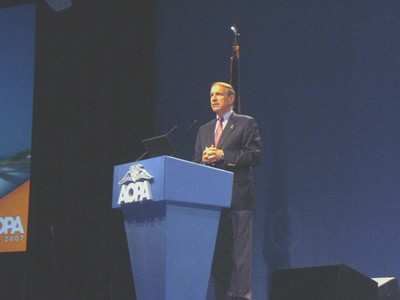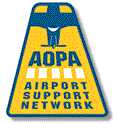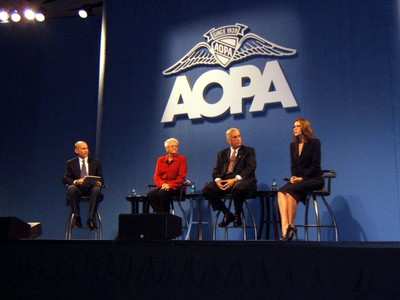Boyer And Others Stress Importance Of Protecting GA
Airports
 The Friday morning
General Session at AOPA Expo 2007 focused on protecting general
aviation airports around the nation. AOPA president Phil Boyer
kicked off the session with examples of how GA has suffered from
airport closures, along with success stories about several airports
that have been saved were presented.
The Friday morning
General Session at AOPA Expo 2007 focused on protecting general
aviation airports around the nation. AOPA president Phil Boyer
kicked off the session with examples of how GA has suffered from
airport closures, along with success stories about several airports
that have been saved were presented.
Boyer recognized the significance of the Airport Support
Network. The ASN is celebrating 10 years of promoting, protecting
and defending airports throughout the nation.
"I am overwhelmed by the passion and enthusiasm that our
volunteers bring to saving and preserving their local airports,"
said ASN Director Stacy Swigart. "With nearly 2,000 volunteers in
all 50 states, the ASN program brings a local face to the fight,
but with the backing of a national organization behind them."
According to Boyer (shown below), there are currently just over
5,000 GA airports in the United States. While this number is down
from years past, the rate of closure has slowed considerably in
recent years.

Meigs Field is the poster child in the fight against airport
closures. Unfortunately, it proves that if a successful and vibrant
airport adjacent to a major city can fall victim to the bulldozer,
then any airport, anywhere is at risk. Legislation is now in place
that prevents such a closure from happening without public
notification, and a 3 million dollar fine was levied against the
mayor and city of Chicago for the Meigs closure.
On the other side of the airport fence is Albert Whitted airport
in St. Petersburg, FL. A few years ago, Whitted was targeted for
closure, with the end goal of turning the airport into a waterfront
park. Unlike the Meigs scenario, the issue was placed on the ballot
for the citizens to decide.
 AOPA launched a vigorous
campaign, targeted specifically to the voter demographics of the
area. The effort was successful, and an overwhelming 78% of local
voters voiced their choice to keep the airport open. With that
said, officials changed their approach... and instead of closing
the field, a new terminal building complete with offices and a
restaurant was built. Improvements have also been made or planned
for runways and taxiways, and a slew of other enhancements.
AOPA launched a vigorous
campaign, targeted specifically to the voter demographics of the
area. The effort was successful, and an overwhelming 78% of local
voters voiced their choice to keep the airport open. With that
said, officials changed their approach... and instead of closing
the field, a new terminal building complete with offices and a
restaurant was built. Improvements have also been made or planned
for runways and taxiways, and a slew of other enhancements.
Also mentioned was the successful fight in San Diego against a
proposed three building office park in San Diego which would have
impacted instrument approach minimums. Upon completion of the first
building, the FAA declared it a hazard. The city looked to AOPA for
assistance. Eventually, an agreement was reached to lower the
building by two floors, and the developer withdrew their permits
for the remaining buildings.
The plight of privately owned, public uses airports was next on
the agenda. In most cases, private airports do not have the
resources of their publicly owned counterparts. They lack funding
from federal, state and local governments. Boyer presented an award
to the Connecticut legislature for their work towards preserving
privately owned airports in the state. House Bill 5536 addresses
the increasing pressures that privately owned public-use airports
face from development. It would give the state first refusal rights
on purchasing a private airport threatened with sale or closure.
The bill would make possible state funding to private airports,
create a new airport zoning category, transfer control of airport
development to the state, and allow the commissioner of
transportation to acquire the development rights of
private-turned-public airports.
In a brief panel discussion -- moderated by Andy Cebula, AOPA's
executive vice president of government affairs -- Shelly deZevallos
spoke of the challenges of operating a privately owned airport. She
said issues of property taxes, insurance, infrastructure
improvements and competing against publicly owned and operated
facilities are all issues.
"Be aware if private airports need your help, and be involved in
the process," deZevallos said. "Keep up on any issues that might
crop up, and educate the public about the benefits of the
airport."

deZevllos -- along with fellow panelists Bob Showalter of
Showalter Flying Service and Woodie Woodward, retired Assistant
Administrator for Airports at the FAA -- agreed that community
involvement is critical in saving airports.
"Educate the community before it becomes an issue. Don't wait
until a developer is knocking on the door" said Woodward. Showalter
agreed, and suggested getting local Chambers of Commerce involved,
stressing that decision makers often fly corporate aircraft,
bypassing airline terminals in favor of smaller airports.
Boyer closed the session with a reminder: "A mile of highway
gets you one mile. A mile of runway gets you anywhere."
 Classic Aero-TV: The Switchblade Flying Car FLIES!
Classic Aero-TV: The Switchblade Flying Car FLIES! ANN FAQ: Q&A 101
ANN FAQ: Q&A 101 ANN's Daily Aero-Term (04.12.24): Discrete Code
ANN's Daily Aero-Term (04.12.24): Discrete Code ANN's Daily Aero-Term (04.13.24): Beyond Visual Line Of Sight (BVLOS)
ANN's Daily Aero-Term (04.13.24): Beyond Visual Line Of Sight (BVLOS) ANN's Daily Aero-Linx (04.13.24)
ANN's Daily Aero-Linx (04.13.24)






